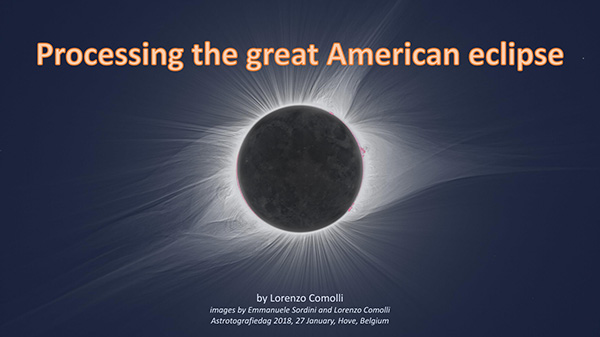
Total Solar Eclipse of 21 August 2017,
USA - Wyoming, Glendo Park, +42°31'10.2" N, 104°59'27.7" W, 1425 m a.s.l.
Local circumstances: C1 16.24.04, C2 17.45.08, max 17.46.22, C3 17.47.36, C4 19.12.15 UT, dur 2m28s
by Lorenzo Comolli

 |
Total Solar Eclipse of 21 August 2017, USA - Wyoming, Glendo Park, +42°31'10.2" N, 104°59'27.7" W, 1425 m a.s.l. Local circumstances: C1 16.24.04, C2 17.45.08, max 17.46.22, C3 17.47.36, C4 19.12.15 UT, dur 2m28s by Lorenzo Comolli |
 |
 Click for hires. Look at the same image superimposed to a Perseus map, with and without the star labels. |
| The HDR
corona with a larger field of view, showing tens of
stars in the field of Leo down to mag. 8.5. Image
collaboration joining the images from two nearly
identical setup. Two Canon 100-400 lenses (used at 150mm f/8), two Canon 6D, two tracking mounts (Vixen GP and Kenko NES), exposures between 1/125 s and 2 s at 400 ISO, plus 2 s at 800 ISO. Nearly 130 total exposures were used. This image is a collaboration between Emmanuele Sordini and Lorenzo Comolli. |
 Click for the PDF presentation |
| On 27 January 2018 I was
invited by VVS association in Belgium for presenting at the
Astrofotografiedag 2018, a conference about astrophotography. One of my
presentation was on how to process the great American eclipse. Look also to the other presentation on the dedicated page. |
 Click for hires |
| Solar
prominences just a second before C3, with also the
chromosphere at maximum visibility. Extreme enlargment
of the original frame. Pentax 75 refractor (500mm f.l. f/6.7), Canon 60D, Kenko NES mount, 1/2000s exposure at 100 ISO. North at top-left. |
 Click for hires |
| Contact C2 and C3 captured at 3 fps. Pentax 75 refractor (500mm f.l. f/6.7), Canon 760D, Vixen GP-DX mount, 1/2000s exposure at 100 ISO. This image is a collaboration between Emmanuele Sordini and Lorenzo Comolli |
 Mouse over for labels. Click for hires with labels and without labels. |
| An All Sky
shot gather all the sky in a single image, a very
important feature when the time is limited like during a
2m28s totality! Four planets and four airplanes are
visible, and also 24 stars. HDR composition obtained at mid totality with a Canon 5D baader, Peleng 8mm f/5.6, exp 2.5s, 1/2s, 1/6s, 800ISO. Identification of stars made with superimposition of an all sky map generated with Perseus software. |
 |
| Rectangular projection
of the above all sky image. The orange/pink horizon is
at 360°. At left my telescope and binocular, and in
the background the dome of the Millikin University. At
right on the horizon the Bennett Hill in the Glendo
National Park. |
| A
solar eclipse greatly influences the Earth atmospere. The
temperature, relative humidity, luminance and pressure
data show typical trends, peculiar to each eclipse and
location. With a digital thermo-hygrometer I've measured a 9°C fall of the temperature respect to the trend (comparison: 4°C in Egipt 2006, 7°C in Hungary 1999). A digital luxmeter measured the horizontal luminance: this is a really interesting measurement, that show the tremendous fall of the light, between full Sun (125000 lux) and totality (only 3.7 lux, comparison: Egipt 2006 4.1 lux). During totality I've measured the sky brightness with a SQM-L, obtaining 12.92 mag/arcsec^2. Comparing this value to the SQM-LE database of Emmanuele Sordini, recording the sky continuously from his home near Varese, Italy, such a value is obtained during twilight when the Sun is at about 5.75° below horizon, i.e. at the civil twilight. Do you what to feel how dark is the sky during totality? Wait for the civil twilight, that is about 30 min after sunset! Here are the plots of:
|
 |
 |
 |
|
|
 |